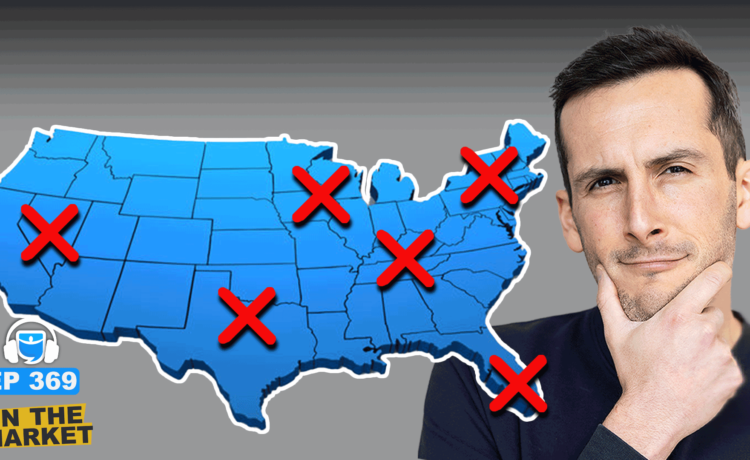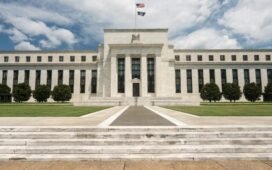Dave:
We are in a housing correction, at least on a national level, but everyone knows real estate and real estate investing are local. What happens in one market can be totally different from what happens in other markets. Where BRRRR works may not be great for short-term rental investing, where short-term rental investing works might not be great for flipping. It all comes down to what you’re trying to accomplish and what’s happening on the ground in your individual market. In today’s episode, we’re going deep into the dramatic regional differences we’re seeing in the housing market across the US and how you can plan your own investing accordingly.
Hey everyone, welcome to On the Market. Thank you all so much for being here. I’m Dave Meyer, and today sort of going back to my roots, this is one of my favorite things to study and talk about real estate markets. We’re going to talk about the regional trends that we’re seeing the opportunities to be had and the risks you probably want to avoid. You might already know this, but there isn’t really such thing as unquote the real estate market on the show. We cover the national market a lot because it’s helpful to understand some big macro trends, but what really matters most to your actual portfolios, to the profits that you’re actually generating is what’s happening on the ground in your local market. And of course, we cannot cover every market in the US and today’s show alone, but in this episode we are going to do a deep dive into housing prices, into different regions, different states, different cities across the US, and help interpret what it all means.
We’ll start with just talking about what has been going on in 2025 and what we know about regional markets as of today in October, 2025. Then we’re going to talk about this sort of interesting and fascinating paradox that’s going on in the investing climate right now. Next, we’ll talk about rent growth and how regional variances there should factor into your investing decisions. Then we’ll even talk about forecast because we just got brand new forecasts showing where prices are likely to go by Citi across the US into 2026. And lastly, I’ll just go over my thesis about markets in general and just remind people what I recommend you do about all the information that we’re going to be sharing in today’s episode. Let’s do it. We’re going to start with the big picture. You’ve heard this on the show a lot recently, but everything is slowing down.
That’s what’s happening on a national level. Of course, we’ve seen regional differences across the years, but the main thing I want everyone to know is even the markets that have been growing the last couple of years, these are your northeast, your Midwest, places like Milwaukee and Detroit and all across western New York and Connecticut. They are still up year over year in nominal terms, but their growth rate, which is something we’re going to talk about a lot today, is slowing down. And in case you’re not familiar with the difference, when I say the growth rate is going down is that maybe last year Milwaukee was up 7% year over year, and now it’s up 3% year over year. So still positive growth, but the amount of growth is less and the trend continues to go down. That is the big broad trend that we’re seeing pretty much everywhere in the United States.
And just to hammer home this point, I want to show that in previous years, well obviously during the pandemic we saw places with 10 15% year over year growth. That’s not normal. Actually, normal appreciation in the housing market is about 3.5%. And so what we’re seeing now is the hottest markets are now at normal. For example, I call that Milwaukee. That’s been a really hot market the last couple of years. That’s now at 3.2%. Detroit’s at 3.7 Rochester, New York at 3.2, Hartford, Connecticut, which has been on fire at 4.2%. So I’m not saying that there’s no pockets of higher growth, I’m just showing that these years of abnormally high growth appear to be over in almost every market in the United States. There are obviously smaller markets, but I’m talking about big major metro areas and almost all of those are now at normal or below average for growth.
And as we’ve talked about in recent episodes where we talked about the difference between nominal, not inflation adjusted prices and real prices, we are also seeing that almost every market is negative in terms of real prices. Inflation right now is 3%, and so any market where prices are up less than 3%, nominally you could argue, is actually down because it’s not growing as fast as the pace of inflation. So that’s where we’re at right now with the hot markets. But obviously there’s the other end of the spectrum too, and I hate to pick on Florida, but when you look at what is going on with Florida, it really is getting pretty bad. I am pretty measured, I feel like about these things. I have not called for a crash the last four years like everyone else has, but what’s going on in Florida specifically is getting to that territory.
In some areas you see in Punta Goda for example, it’s down 13% in just a year. Cape Coral is down 10% in just a year, and we’ll talk about forecasts in just a little bit, but they’re not forecast to get better. And what I’m looking at a map right now as I talk, it’s from Zillow, it just shows basically what’s happened year over year in all these markets. And a lot of states are a mixed bag. Even states like Texas, which has a lot of declining markets, a lot of them are just kind of flat and there are still some markets that are positive, there are pockets of good that’s not happening in Florida. Florida has been just hit by so many different things, whether it’s the oversupply issue, the insurance cost issue, the special assessments going on with condos there, the overbuilding issue. There’s just so much going on there that I think it would be safe to say that Florida is on a statewide sort of crash watch.
It’s not there yet, but I think there is a decent chance that we will see double digit losses across the state of Florida from the peak of where they were to the bottom, where they will eventually bottom out. But I don’t think we’re close to that right now. Other areas of weakness, like I said, are Texas and really along the Gulf Coast with Louisiana seeing pretty weak areas too. Arizona’s also been struggling, and then on the west coast it’s kind of just all flat. There are some markets in California that definitely aren’t doing well. There’s some that are mildly up. Same thing’s going on with Oregon. Same things going on with Washington, Idaho, all along there. You’re kind of seeing just a mixed flag of mostly flat stuff. I want to also just talk quickly about a recent report that I saw from realtor.com talking about the hottest markets in the US because realtor.com, they can look at this stuff in real time, which properties are getting the most listings, have the shortest inventory, shortest days on market, and so they put out this report for the hottest markets in the US and I want you all to think about what the common thread is while I read off a couple of these things and we’ll talk about it.
Number one, Springfield, Massachusetts. Then we have Hartford. So again, Hartford, hottest growth last year, still really hot. Kenosha, Wisconsin, Lancaster, Pennsylvania, Appleton, Wisconsin, Wausau, Wisconsin, Racine, Wisconsin, Rockford, Illinois, Beloit, Wisconsin, green Bay, Wisconsin, all in the top 10. Then we have a couple others, I’m not going to read them all, but in the northeast like Manchester, New Hampshire, Providence, Rhode Island, Worcester, Massachusetts, Milwaukee, all of this. So what do you notice about these markets? Well, yeah, a lot of them are in Wisconsin. Wisconsin is on fire right now, but what I notice here and has been my thesis about the housing market for God years now is affordability. All of these markets, all of the markets that are still doing well that are still hot are relatively affordable, meaning the people who live in that market can afford to buy homes. It’s not like you need inbound migration or you need massive amounts of job growth right now it’s just that regular people who are gainfully employed in this market can go out and buy a home.
Those are the markets that are doing well, and I believe it’s the markets that are going to continue to do well. And you might be thinking, wow, the Northeast is very unaffordable. Why are you calling those markets affordable? It’s all relative because even with a generally expensive region like New England or the Northeast, there are more affordable options that are hot right now. For example, new Haven, Hartford, Connecticut, new London, Connecticut, all these places in Connecticut. Why are they so hot right now? Well, they’re directly between Boston and enormous economic hub that is very expensive and New York City, an enormous economic hub that is very expensive. So if you’re looking to live in this region and maybe you only have to go into the office a couple of days a week, Connecticut is looking like a very attractive option because it is relatively far more affordable than these other options in the Northeast.
That’s why I say it’s all about affordability. Providence, Rhode Island been a very, very hot market the last couple of years. Same with Worcester, Massachusetts, and yeah, the median home price in those markets is way above the national average at $550,000, but it’s not Boston where the median home price is over $800,000. So to me, what’s happening is it’s all about relative affordability. And this is a really important takeaway because people say things like you can’t invest in the Northeast or California or Washington state. Well, clearly there are pockets of places that are growing, and I am not saying that affordable markets are going to be completely insulated from the correction that we are in because I believe a lot of these markets are going to decline, but affordable places in my mind are going to see the least dramatic dips in the coming years. So look at Austin, that is an awesome market, but it got way more expensive for the average person who lives there over the last couple of years.
Combine that with supply issues and you see a big correction. Same thing went out in Boise. Same thing going on in Las Vegas. And actually that brings us to the next thing I wanted to talk about, which is the other side of the coin. We just talked about the top 20 or so markets that are the hottest right now. What about the coolest or if you want to frame it in positive terms, you could call it the strongest buyer’s market in the United States right now. Number one, I didn’t even plan this, but is Austin, Texas shocking, shocking, where you were in a place where sellers outnumber buyers by 130%? This is wild. Think about this. So this is a report that came out from Redfin and it shows that right now in Austin there are 17,403 sellers right now, how many buyers are there? 7,568.
That’s a difference of nearly 10,000 buyers. There are 10,000 buyers missing in Austin right now. So if you want to just peek ahead to what we’re going to talk about soon about where these prices are going in a market like that, they’re going down. See similar things in Fort Lauderdale where it’s 118% West Palm Beach, Miami, Nashville, San Antonio, Dallas, Jacksonville, Las Vegas, and Houston. Those are the top 10. So pretty much all in Texas and Florida, you also have Nashville and Las Vegas thrown in there, but those of the biggest markets in the country are seeing the biggest imbalances right now, which means buyers have the most power, but prices are also likely to drop. And this situation actually brings up this kind of interesting paradox that’s going on in real estate right now where there are some really good markets that are in deep corrections. So does that make that a really good opportunity or a lot of risk? We’ll get into that right after this break. Stay with us.
Welcome back to On The Market. I’m Dave Meyer going over some regional trends that we’re seeing in the housing market right now. Before the break, we talked about what’s been going on with prices. We talked about some of the hottest markets, mostly in the Northeast and in Wisconsin specifically, we talked about the coolest markets, which are mostly in Florida and Texas. We had Vegas and Nashville on top of that, but I wanted to talk about this a little bit more. I think there’s this interesting paradox that’s been going on for a couple of years and I think it’s just going to get more dramatic, which is that some of the markets that are experiencing the biggest corrections and are likely to go into further corrections are markets with pretty good long-term fundamentals. Austin, Texas, it gets picked on a lot because it’s been beat up for three years right now, but there’s still a lot of good stuff going on in Austin.
It’s still a very desirable place to live. It has good job growth. It’s the state capital. There’s a giant university. There are a lot of things to like about the Austin market. The same thing goes with Nashville, right? That’s been one of the hottest, most popular cities in the country. Dallas has a lot of great fundamentals and the list goes on. I invest in Denver. It’s not on this top 10 list, but the same thing is absolutely going on in Denver where prices are going down a little bit. Rents are even going down in Denver, but it’s a city with really good long-term fundamentals. And so this is something I just think that you should consider as an investor. I’ll talk about this a little bit more at the end when I talk about what to do about this, but if you are an investor who is willing to take risk and wants to take a big swing, you’re going to be able to buy good deals in these markets.
Good deals are coming in Austin, they’re coming in Nashville, they’re coming in Dallas. I can tell you that if you are looking at a market like Dallas where there’s 32,000 sellers and only 16,000 buyers, you’re going to be able to negotiate because for every single buyer there’s two homes. So there is going to be tons of opportunity to negotiate. Now of course, you’re going to have to protect yourself and you nudity to take a long-term mindset because we don’t know when these markets are going to bottom out. But I do think this situation is going to become even more dramatic where I’m going to borrow a word from the stock market, but some of these markets might become what you would call oversold, the supply and demand dynamics just shift in a way where prices go down probably more than they should. A lot of these markets do need to come down in terms of affordability, but I think you’re going to be able to find good deals in these markets in the next couple of years if you are willing to take on a little bit of extra risk to realize what will potentially be some outsize gains in the future.
Now, I want to turn our attention now to some forecasts for what is likely to happen over the next year because Zillow actually just put out their forecast for metro price changes between September, 2025, September, 2026, and I know people like to hate on estimates, but Zillow has been pretty good about this. They’ve been pretty accurate about their aggregate macro level forecasts, and it’s something I definitely look at and what they’re forecasting is a lot more of a mixed bag. So we are going to see the Northeast and the Midwest that have been pretty good, still be pretty good. They’re probably still going to lead the country regionally, but it’s going to come a lot closer to flat in the next year. And they’re also forecasting that even the markets that are down Austin, for example, they’re also going to come closer to flat. Just as an example, Zillow believes that the fastest growing market over the next year will be Atlantic City, New Jersey with 5% growth.
We have Rockford, Illinois, and Concord, New Hampshire at 5%, Knoxville, Tennessee at 5% Saginaw, Michigan at 5% Fayetteville, Arkansas. Shout out to Henry at 4.8% Hilton Head, Connecticut, and then more places in Connecticut. But we’re getting some other places. Towards the bottom of the list, Jacksonville, North Carolina, we’re seeing Morristown, Tennessee. So a lot of places in the Northeast, they’re projecting that the Midwest cools down a little bit, but the Carolinas and Tennessee, which have been really strong for the last decade, but a little weak in the last year starting to rebound. Meanwhile, if you look at what they’re forecasting for the lowest performing markets, it doesn’t look good for Louisiana. The bottom five markets are all forecasted to be in Louisiana, Huma Lake, Charles Lafayette, new Orleans, Shreveport, you skip a couple, and then Alexandria, Louisiana, Monroe, Louisiana, all told seven out of the top 10 are in Louisiana.
The rest are mostly in Texas. We have Beaumont, Odessa, Corpus Christi. Then we see San Francisco, California, Chico, California, Punta Goda, Florida. Mostly what they’re projecting is a year of more flatness. They’re not projecting most markets to go down by more than one or 2%. The majority of markets in Zillow’s forecast or between negative 2% and plus 2%. So that’s where Zillow thinks we’re going. And most other forecasters don’t put out monthly forecasts like Zillow. That’s why I like this, is they are just constantly looking at new data, taking it in and updating their forecast. Whereas a lot of the other companies put this out annually, and so we will get a lot more forecast towards the end of the year, but this is the most recent one we have, and I do think it’s pretty reasonable. Obviously they’re not going to be right about everything, but I think they’re generally in the right direction based on the other data that I’ve been tracking, inventory levels, housing dynamic levels across the country. I think they’ve done a good job here. Alright, we got to take one more quick break, but when we come back, we’re looking at rents and how that factors into the equation, regional differences there, and we’ll talk about what you should do about all this and how you should be making investing decisions based on this information. We’ll be right back.
Welcome back to On the Market. I’m Dave Meyer going over regional data that we’re seeing in the housing market. We’ve now gone deep into prices in the us. We’ve talked about what happened over the last year, what’s happening right now in the hottest markets, biggest buyer’s markets, and then we looked at Zillow’s forecast for what’s likely to happen over the next year. I want to turn our attention to one more dataset before we do the whole. So what of this whole thing and talk about what you should be doing about this and that’s rent because obviously this is going to matter a great deal in your own investing decisions. What we see over the last year is largely similar regional trends. There are some differences that we are going to talk about, but if you look at where rent growth has been the hottest it has been in the northeast and in the Midwest.
I’m looking at a map of it right now, and they’re showing they’re using a color code where anything that grew is red. It’s all red. There’s no place in the northeast or the Midwest, maybe one place in Iowa, but the rest are all positive. Meanwhile, if you look at the place where rents are declining the most, you see Arizona and the Phoenix area is bad. The west coast of Florida, which is just getting hammered, Denver, which I alluded to before, Houston and Dallas, and in places like Georgia and in Tennessee as well. If you want the official list, the fastest year over year rent change, this is going to surprise you guys. You are not going to guess this because it’s not in the northeast and it’s not in the Midwest. Fastest year over year rent growth in the country goes to San Francisco, California at 5%.
It’s interesting because prices are going down there, but rents are going up. We also see Chicago at 4%. I’m always boosting Chicago. This is why 4% year over year. Other rent growth really strong in California, Fresno and San Jose, Providence, Rhode Island, Minneapolis, Virginia Beach, Pittsburgh, New York, and Richmond, Virginia. So not huge surprises there, but I didn’t expect San Francisco and Chicago to be at the top of that list. Meanwhile, the slowest year over year rent growth, this one doesn’t surprise me at all. Number one, sorry Austin, but you are taking the top spot again, or I should say bottom spot because negative 6.5% year over year. My own portfolio is feeling it with the number two spot in Denver, Colorado, negative 5%. Then we see Arizona, Phoenix, and Tucson, new Orleans and San Antonio at negative three and a half and we have Memphis, Orlando, and Dallas as well.
Now I’m calling this out because I think again, there are some really interesting dynamics here. I’ll call out my own portfolio and just admit that I am seeing rent declines in my bad apartments. Any of my units that are really great, unique properties that have a lot of value, those are renting fine. Nothing has happened to those. But for example, I was just renting a basement unit. It’s just kind of a bad unit. I’ve tried renovating it. The layout just doesn’t work, but it’s a basement and it can’t move the walls and it just kind of stinks and the rent has fallen there from 1900 bucks a month to 1700 bucks a month. That’s what I was just able to lease it out for. So that’s a pretty significant decline I could have maybe held on longer, but I didn’t want vacancy. But that’s the kind of stuff I’m seeing in my own market.
Now that worries me about buying in Denver right now because I am not really that worried about price declines, but price declines combining with rent declines. It’s not the best. That’s not exactly what you want to be investing in. Now, you still can find pockets where things are growing. For sure there are going to be neighborhoods and areas for sure, but if I’m just looking on a metro level, that worries me a little bit. Meanwhile, when you look at some markets like in California or in Washington, or actually a bunch of markets in Texas for example, or South Carolina, we’re seeing this as well. Prices are flat to falling, but rents are still going up. And this is something that I feel like is lost in all this discussion about what’s happening in the real estate market right now is that in some of these markets, arguably in many of these markets over the next two to three years, cashflow prospects will finally be getting better after years of getting worse.
We are definitely seeing this across a lot of the country and I think it’s a trend that is going to continue. So I really recommend as we sort of move into our next section here, talking about what to do about this, looking at these things in conjunction because again, you can invest in a market with declining rents and declining prices, but you got to get a killer deal. You have to get a smoking deal for that to work. Meanwhile, if you’re buying in a market that’s flat, which I think is going to be the majority of markets for the next few years, I think they’re going to be relatively flat. You’re buying in a market that’s flat, but rents are going up. That’s still a good deal to me. Obviously you still want to try and get a great deal, but if you can buy something at a good price and prices maybe don’t appreciate for a couple of years, but rents are going, I still think that has a lot of upside potential and those are the kinds of markets and deals that I would still personally be interested in.
So that is one of my takeaways. But just a couple other takeaways before we get out of here. I personally believe affordability is going to continue to drive market divergence. This has been the thing I’ve been harping on for years, and I’m sorry if you’re tired of me saying it, but it’s still true. I will be wrong about many things, but I have been accurate about this, that affordability is going to drive market divergence, and I think this is still going to be true, and I encourage you to not just look at home prices, but look at total affordability because again, people might look at a $550,000 home in Providence, Rhode Island and say, that’s not affordable. But for people who live there who make good salaries and where the tax burden isn’t as high as certain places, it is relatively more affordable. And I think this is what’s happening to Florida right now.
Prices went up, insurance went up, special assessments went up. It is expensive in Florida right now, and that is a major reason that we’re seeing those corrections there. So I would really, if you want to be a conservative investor and if you’re worried about price declines, I really think affordability is probably one of the two best ways I would look at data to try and mitigate risk. So affordability is one. The second one I alluded to a minute ago, which is supply. You need to look at places that are not going to have massive increases in supply. The reason we’re seeing bad conditions in Florida or in Nashville or in places in Texas, because they’re also overbuilt. They’re having the combined issues of affordability and too much supply. That’s why they’re seeing corrections. And so if you want to find places to invest, I think looking for places that are affordable with limited supply risk is probably going to be the lowest risk potential for deals over the next couple of years.
But I want to call out that that’s not the only way to invest right now because if you’re a buy and hold investor, it really is a question of preference because with bigger risk often comes bigger reward. If you want to take more risk and pursue more reward with your own investing, now is a decent time to do it. There’s going to be risk, but can you buy something in Austin, 10 or 15% off peak? Maybe? What about in California? In Florida you might be able to buy something 20% offbeat. I don’t know for sure, but those kinds of numbers are intriguing. And of course you’re going to have to set yourself up so that you have cashflow, you have sufficient reserves so that you can hold onto that for a long time. But that is not an unreasonable strategy right now. I think we’re probably going to see institutional investors that have a lot of capital start to try and do these things.
Looking at markets like Nashville that have been super hot over the last couple of years, if they could start buying those at 10%, they’ll wait three or four years to the appreciation returns. Not saying this is for everyone, but that is an option that you have as a buy and hold investor. Now, I’m not saying just go and buy in any of those markets. Don’t just buy the dip. Don’t buy in Punta Gorda, Florida right now. One of the reasons Punta Gore is going down so much is because it doesn’t have an economic engine. It was a lot of people moving during COVID for the lifestyle, which is fine, but when that pulls back, when there’s return to office, that market got hit. Nashville, Austin, Denver, these are places with very strong job markets. These are places that have a high quality of life that people want to live there.
And so if you want to take these risks, look for the ones that have these strong fundamentals like the ones I mentioned, and those can be decent options for investing right now that’s buy and Holt. I think flipping is going to be risky right now, especially in correcting markets. But an interesting thing happens in flipping during corrections like this where the price of distressed C-Class homes go down more than a class homes. And so actually sometimes you get a widening margin. So the opportunity for flipping actually gets better. You just have to prepare for your property to sit on the market for three months or six months instead of two days or three days we’ve seen over the last couple of years. Last thing I want to say is that I think just generally over the next few years, we’re going to be going back to more normal regional variation because we’ve seen some very, very abnormal stuff over the last couple of years.
It is not normal for all markets to be going up all the time. It is not normal for any market to be growing more than 10% year over year. It’s not normal for most markets to be up over 7% year over year. This stuff that we’ve seen over the last four or five years is not normal. I think instead what we’re going to see is a move back to sort of this traditional tradeoff that has almost always existed in real estate investing, which is the trade-off between appreciation and cashflow. I think Midwest affordable markets are going to go back to being better for cashflow. They’ll still have slow and steady appreciation, but I’m not sure we’re going to see this outsized appreciation for years in the Midwest. I think if you want to sort of summarize it, I’d say the Midwest is going to be easier, doubles, harder home runs when then you look at these other markets like the ones we’ve talked about in Austin and Denver and Vegas and Phoenix.
These are markets where you could take bigger swings right now. You might hit a home run, but you could strike out. So you definitely need to mitigate risk in those markets, but I think that’s sort of what we’re going to get to. So that’s what I would prepare for. And to me that’s good. I want that. I would love to just see a market that we could say for the next three to five years, we’re probably just going to see normal three to 4% appreciation. That would be fantastic. We’re not there yet. We’re in a correction. We don’t know when it’s going to bottom out, but my hope is that because this correction exists, because affordability needs to be restored, that once we’ve been in this correction for a little while, we can get back to a normal housing market on a national level. And to me, that also means we’re going to return to those normal regional variances where markets that have strong economic engines, strong population and household growth are going to see the appreciation where the other markets that are still good markets are going to be more cashflow centric markets. And that’s okay. And as investors, if it becomes predictable again, we can absolutely work with that. I would love to work with that. Let’s all hope that’s what we see after this correction in the next couple of years. Alright, that’s what we got for you guys today on the market. I’m Dave Meyer. Thank you all so much for listening. If you like this show or think that your friends would benefit from knowing some of this information, please share it with them. Thanks again. We’ll see you next time.
Help us reach new listeners on iTunes by leaving us a rating and review! It takes just 30 seconds and instructions can be found here. Thanks! We really appreciate it!
Interested in learning more about today’s sponsors or becoming a BiggerPockets partner yourself? Email [email protected].















